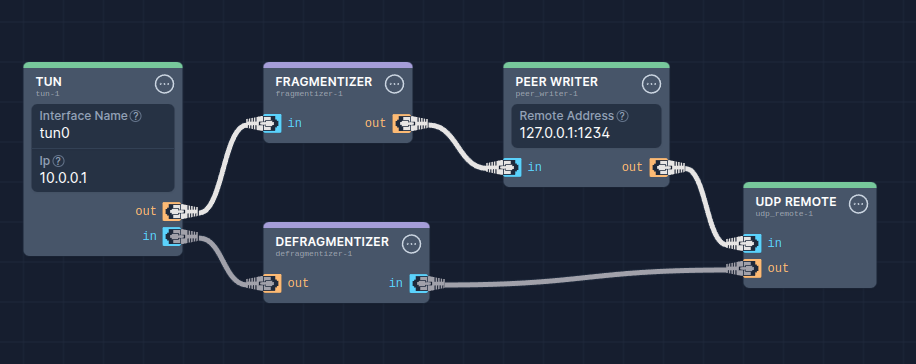TUN to UDP Tunnel (Unoptimized)
This guide explains how to set up a basic TUN over UDP tunnel between two NanoPing devices.
Unfamilar with TUN read more here
System Requirements
The setup requires two devices:
- Client – Sends packets to the server.
- Server – Receives packets from the client.
Once the connection between the client and server is established (i.e., the client has sent the first packet), communication becomes bidirectional.
Configuration
The setup involves two pipelines:
Client Pipeline

This pipeline reads packets from the TUN interface (tun0) and sends them to the remote address specified in the PEER_WRITER component.
Configuration Steps
- Update the Remote Address – Change the Remote Address in the
PEER_WRITERcomponent to the actual IP address where the Server will be running. - Download the Client Pipeline – Download here
- Import the Pipeline – Upload the downloaded pipeline to your NanoPing instance via the pipeline overview.
Server Pipeline

This pipeline reads packets from the UDP_LOCAL component and forwards them to the TUN interface (tun1) for processing by the Linux network stack.
Configuration Steps
- Download the Server Pipeline – Download here
- Import the Pipeline – Upload the downloaded pipeline to your NanoPing instance via the pipeline overview.
- Update the UDP Local Address – Modify the Address field of the
UDP_LOCALcomponent to match the interface on the server that will be used for reading packets.
By following these steps, you will establish a TUN over UDP tunnel for bidirectional communication between your NanoPing devices.
Read more: To use this setup as a VPN, follow the guide on TUN Interface Setup with iptables.
The pipelines shown here do not include components for encryption or authentication. Use them for testing and evaluation purposes only.
Testing Connectivity
🎉 Congratulations! Your TUN-over-UDP tunnel is now successfully set up.
You can now verify and evaluate the performance of your tunnel. There are many ways to do this—below are two recommended methods using ping and iperf3:
-
Test tunnel performance with iperf3 Measure throughput, packet loss, and jitter using TCP or UDP traffic.
-
Test tunnel performance with ping Check connectivity and measure round-trip time (RTT) between endpoints.